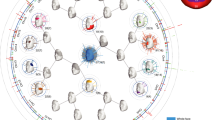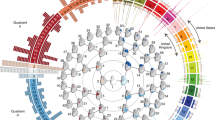Abstract
An adaptive variant of human Ectodysplasin receptor, EDARV370A, had undergone strong positive selection in East Asia. In mice and humans, EDARV370A was found to affect ectodermal-derived characteristics, including hair thickness, hair shape, active sweat gland density and teeth formation. Facial characteristics are also largely ectodermal derived. In this study, taking advantage of an admixed population of East Asian and European ancestry—the Uyghur, we aim to test whether EDARV370A is affecting facial characteristics and to investigate its pleiotropic nature and genetic model. In a sample of 1027 Uyghurs, we discover that EDARV370A is significantly associated with several facial characteristics, in particular shape of earlobe (P = 3.64 × 10 −6) and type of chin (P = 9.23 × 10 −5), with successful replication in other East Asian populations. Additionally, in this Uyghur population, we replicate previous association findings of incisors shoveling (P = 1.02 × 10 −7), double incisors shoveling (P = 1.86 × 10 −12) and hair straightness (P = 3.99 × 10 −16), providing strong evidence supporting an additive model for the EDARV370A associations. Partial least square path model confirms EDARV370A systematically affect these weakly related ectodermal-derived characteristics, suggesting the pleiotropic effect of EDARV370A mainly plays roles in early embryo development. This study extends our knowledge about the pleiotropic nature of EDARV370A and provides potential clues to its adaptation fitness in human evolution.




Similar content being viewed by others
References
Adhikari K, Reales G, Smith AJ, Konka E, Palmen J, Quinto-Sanchez M, Acuna-Alonzo V, Jaramillo C, Arias W, Fuentes M, Pizarro M, Barquera Lozano R, Macin Perez G, Gomez-Valdes J, Villamil-Ramirez H, Hunemeier T, Ramallo V, Silva de Cerqueira CC, Hurtado M, Villegas V, Granja V, Gallo C, Poletti G, Schuler-Faccini L, Salzano FM, Bortolini MC, Canizales-Quinteros S, Rothhammer F, Bedoya G, Calderon R, Rosique J, Cheeseman M, Bhutta MF, Humphries SE, Gonzalez-Jose R, Headon D, Balding D, Ruiz-Linares A (2015) A genome-wide association study identifies multiple loci for variation in human ear morphology. Nat Commun 6:7500. doi:10.1038/ncomms8500
Aiello L, Dean C (1990) An introduction to human evolutionary anatomy. Academic Press, London
Bhowmik D (1971) Earlobe attachment in Uttar Pradesh. Man India 51:157–161
Bryk J, Hardouin E, Pugach I, Hughes D, Strotmann R, Stoneking M, Myles S (2008) Positive selection in East Asians for an EDAR allele that enhances NF-kappaB activation. PLoS One 3:e2209. doi:10.1371/journal.pone.0002209
Cluzeau C, Hadj-Rabia S, Jambou M, Mansour S, Guigue P, Masmoudi S, Bal E, Chassaing N, Vincent MC, Viot G, Clauss F, Maniere MC, Toupenay S, Le Merrer M, Lyonnet S, Cormier-Daire V, Amiel J, Faivre L, de Prost Y, Munnich A, Bonnefont JP, Bodemer C, Smahi A (2011) Only four genes (EDA1, EDAR, EDARADD, and WNT10A) account for 90% of hypohidrotic/anhidrotic ectodermal dysplasia cases. Hum Mutat 32:70–72. doi:10.1002/humu.21384
Cluzeau C, Hadj-Rabia S, Bal E, Clauss F, Munnich A, Bodemer C, Headon D, Smahi A (2012) The EDAR370A allele attenuates the severity of hypohidrotic ectodermal dysplasia caused by EDA gene mutation. Br J Dermatol 166:678–681. doi:10.1111/j.1365-2133.2011.10620.x
Falush D, Stephens M, Pritchard JK (2003) Inference of population structure using multilocus genotype data: linked loci and correlated allele frequencies. Genetics 164:1567–1587
Falush D, Stephens M, Pritchard JK (2007) Inference of population structure using multilocus genotype data: dominant markers and null alleles. Mol Ecol Notes 7:574–578. doi:10.1111/j.1471-8286.2007.01758.x
Fuerle RD (2008) Erectus walks amongst us. Spooner Press, New York
Fujimoto A, Kimura R, Ohashi J, Omi K, Yuliwulandari R, Batubara L, Mustofa MS, Samakkarn U, Settheetham-Ishida W, Ishida T, Morishita Y, Furusawa T, Nakazawa M, Ohtsuka R, Tokunaga K (2008a) A scan for genetic determinants of human hair morphology: EDAR is associated with Asian hair thickness. Hum Mol Genet 17:835–843. doi:10.1093/hmg/ddm355
Fujimoto A, Ohashi J, Nishida N, Miyagawa T, Morishita Y, Tsunoda T, Kimura R, Tokunaga K (2008b) A replication study confirmed the EDAR gene to be a major contributor to population differentiation regarding head hair thickness in Asia. Hum Genet 124:179–185. doi:10.1007/s00439-008-0537-1
Grossman SR, Shlyakhter I, Karlsson EK, Byrne EH, Morales S, Frieden G, Hostetter E, Angelino E, Garber M, Zuk O, Lander ES, Schaffner SF, Sabeti PC (2010) A composite of multiple signals distinguishes causal variants in regions of positive selection. Science 327:883–886. doi:10.1126/science.1183863
Grossman SR, Andersen KG, Shlyakhter I, Tabrizi S, Winnicki S, Yen A, Park DJ, Griesemer D, Karlsson EK, Wong SH, Cabili M, Adegbola RA, Bamezai RN, Hill AV, Vannberg FO, Rinn JL, Lander ES, Schaffner SF, Sabeti PC (2013) Identifying recent adaptations in large-scale genomic data. Cell 152:703–713. doi:10.1016/j.cell.2013.01.035
Hubisz MJ, Falush D, Stephens M, Pritchard JK (2009) Inferring weak population structure with the assistance of sample group information. Mol Ecol Resour 9:1322–1332. doi:10.1111/j.1755-0998.2009.02591.x
Hunter AG, Yotsuyanagi T (2005) The external ear: more attention to detail may aid syndrome diagnosis and contribute answers to embryological questions. Am J Med Genet A 135:237–250. doi:10.1002/ajmg.a.30723
Kamberov YG, Wang S, Tan J, Gerbault P, Wark A, Tan L, Yang Y, Li S, Tang K, Chen H, Powell A, Itan Y, Fuller D, Lohmueller J, Mao J, Schachar A, Paymer M, Hostetter E, Byrne E, Burnett M, McMahon AP, Thomas MG, Lieberman DE, Jin L, Tabin CJ, Morgan BA, Sabeti PC (2013) Modeling recent human evolution in mice by expression of a selected EDAR variant. Cell 152:691–702. doi:10.1016/j.cell.2013.01.016
Kimura R, Yamaguchi T, Takeda M, Kondo O, Toma T, Haneji K, Hanihara T, Matsukusa H, Kawamura S, Maki K, Osawa M, Ishida H, Oota H (2009) A common variation in EDAR is a genetic determinant of shovel-shaped incisors. Am J Hum Genet 85:528–535. doi:10.1016/j.ajhg.2009.09.006
Medland SE, Nyholt DR, Painter JN, McEvoy BP, McRae AF, Zhu G, Gordon SD, Ferreira MA, Wright MJ, Henders AK, Campbell MJ, Duffy DL, Hansell NK, Macgregor S, Slutske WS, Heath AC, Montgomery GW, Martin NG (2009) Common variants in the trichohyalin gene are associated with straight hair in Europeans. Am J Hum Genet 85:750–755. doi:10.1016/j.ajhg.2009.10.009
Moldenhauer W (1877) Die Entwickelung des mittleren und des a¨usseren Ohres. Morph Jahrb 3:106–151 (cited in Streeter, 1922)
Mou C, Thomason HA, Willan PM, Clowes C, Harris WE, Drew CF, Dixon J, Dixon MJ, Headon DJ (2008) Enhanced ectodysplasin-A receptor (EDAR) signaling alters multiple fiber characteristics to produce the East Asian hair form. Hum Mutat 29:1405–1411. doi:10.1002/humu.20795
Nakamura M, Ikeda T, Shioya N (1995) Side-to-side earlobe variations with respect to surface area and shape: a quantitative study. Aesthetic Plast Surg 19:561–565
Overfield T, Call EB (1983) Earlobe type, race, and age: effects on earlobe creasing. J Am Geriatr Soc 31:479–481
Park C (1999) Lower auricular malformations: their representation, correction, and embryologic correlation. Plast Reconstr Surg 104:29–40
Park JH, Yamaguchi T, Watanabe C, Kawaguchi A, Haneji K, Takeda M, Kim YI, Tomoyasu Y, Watanabe M, Oota H, Hanihara T, Ishida H, Maki K, Park SB, Kimura R (2012) Effects of an Asian-specific nonsynonymous EDAR variant on multiple dental traits. J Hum Genet 57:508–514. doi:10.1038/jhg.2012.60
Pritchard JK, Stephens M, Donnelly P (2000) Inference of population structure using multilocus genotype data. Genetics 155:945–959
Sabeti PC, Varilly P, Fry B, Lohmueller J, Hostetter E, Cotsapas C, Xie X, Byrne EH, McCarroll SA, Gaudet R, Schaffner SF, Lander ES, Frazer KA, Ballinger DG, Cox DR, Hinds DA, Stuve LL, Gibbs RA, Belmont JW, Boudreau A, Hardenbol P, Leal SM, Pasternak S, Wheeler DA, Willis TD, Yu F, Yang H, Zeng C, Gao Y, Hu H, Hu W, Li C, Lin W, Liu S, Pan H, Tang X, Wang J, Wang W, Yu J, Zhang B, Zhang Q, Zhao H, Zhou J, Gabriel SB, Barry R, Blumenstiel B, Camargo A, Defelice M, Faggart M, Goyette M, Gupta S, Moore J, Nguyen H, Onofrio RC, Parkin M, Roy J, Stahl E, Winchester E, Ziaugra L, Altshuler D, Shen Y, Yao Z, Huang W, Chu X, He Y, Jin L, Liu Y, Sun W, Wang H, Wang Y, Xiong X, Xu L, Waye MM, Tsui SK, Xue H, Wong JT, Galver LM, Fan JB, Gunderson K, Murray SS, Oliphant AR, Chee MS, Montpetit A, Chagnon F, Ferretti V, Leboeuf M, Olivier JF, Phillips MS, Roumy S, Sallee C, Verner A, Hudson TJ, Kwok PY, Cai D, Koboldt DC, Miller RD, Pawlikowska L, Taillon-Miller P, Xiao M, Tsui LC et al (2007) Genome-wide detection and characterization of positive selection in human populations. Nature 449:913–918. doi:10.1038/nature06250
Schwartz JH, Tattersall I (2000) The human chin revisited: what is it and who has it? J Hum Evol 38:367–409. doi:10.1006/jhev.1999.0339
Scott GR, Turner CGI (1997) The anthropology of modern human teeth. Cambridge University Press, Cambridge
Tan J, Yang Y, Tang K, Sabeti PC, Jin L, Wang S (2013) The adaptive variant EDARV370A is associated with straight hair in East Asians. Hum Genet 132:1187–1191. doi:10.1007/s00439-013-1324-1
Tan J, Peng Q, Li J, Guan Y, Zhang L, Jiao Y, Yang Y, Wang S, Jin L (2014) Characteristics of dental morphology in the Xinjiang Uyghur and correlation with the EDARV370A variant. Sci China Life Sci 57:1–9
Tenenhaus M, Vinzi VE, Chatelin Y-M, Lauro C (2005) PLS path modeling. Comput Stat Data Anal 48:159–205. doi:10.1016/j.csda.2004.03.005
Turner CG, Nichol CR, Scott GR (1991) Scoring procedures for key morphological traits of the permanent dentition: the Arizona State University dental anthropology system. In: Kelley M, Larsen C (eds) Advances in dental anthropology. Wiley-Liss, New York, pp 13–32
Wu X, Xi HZC (2010) Human body measurements (Chinese Version). Science Press, Beijing
Xu S, Jin L (2008) A genome-wide analysis of admixture in Uyghurs and a high-density admixture map for disease-gene discovery. Am J Hum Genet 83:322–336. doi:10.1016/j.ajhg.2008.08.001
Xu S, Huang W, Qian J, Jin L (2008) Analysis of genomic admixture in Uyghur and its implication in mapping strategy. Am J Hum Genet 82:883–894. doi:10.1016/j.ajhg.2008.01.017
Xu S, Jin W, Jin L (2009) Haplotype-sharing analysis showing Uyghurs are unlikely genetic donors. Mol Biol Evol 26:2197–2206. doi:10.1093/molbev/msp130
Acknowledgments
This work was supported by the National Natural Science Foundation of China (31322030, 91331108 to S.W., 30890034, 31271338 to L. J., 91331204, 31171218 to S. X., 31401061 to Q. P., 31071102 to J. T., 31071096 to Y. Y.), National Science and Technology Infrastructure Program (2015FY111700 to L. J.), the National Basic Research Program (2012CB944600 to L. J.), Ministry of Science and Technology (2011BAI09B00 to L. J.), Ministry of Education (311016 to L. J.), National High-Tech Research and Development Program (2012AA021802 to Y.Y.), Chinese Academy of Sciences (XDB13040100 to S.X., 2014KIP214 to Q. P.), the National Program for Top-notch Young Innovative Talents of The “Wanren Jihua” Project to S. X., National Thousand Young Talents Award to S. W., Max Planck-CAS Paul Gerson Unna Independent Research Group Leadership Award to S. W., the State Key Laboratory of Genetic Engineering, Fudan University to S. W., and key lab of computational biology of Chinese Academy of Sciences to J. T.
Author information
Authors and Affiliations
Corresponding authors
Ethics declarations
Conflict of interest
The authors declare that they have no conflict of interest.
Additional information
Qianqian Peng, Jinxi Li, Jingze Tan and Yajun Yang contributed equally to this study.
Li Jin and Sijia Wang co-directed this study.
Electronic supplementary material
Below is the link to the electronic supplementary material.
Rights and permissions
About this article
Cite this article
Peng, Q., Li, J., Tan, J. et al. EDARV370A associated facial characteristics in Uyghur population revealing further pleiotropic effects. Hum Genet 135, 99–108 (2016). https://doi.org/10.1007/s00439-015-1618-6
Received:
Accepted:
Published:
Issue Date:
DOI: https://doi.org/10.1007/s00439-015-1618-6




